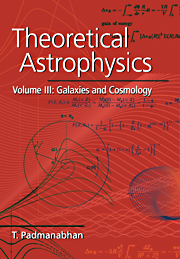Book contents
- Frontmatter
- Contents
- Preface
- 1 Overview: Galaxies and Cosmology
- 2 Galactic Structure and Dynamics
- 3 Friedmann Model of the Universe
- 4 Thermal History of the Universe
- 5 Structure Formation
- 6 Cosmic Microwave Background Radiation
- 7 Formation of Baryonic Structures
- 8 Active Galactic Nuclei
- 9 Intergalactic Medium and Absorption Systems
- 10 Cosmological Observations
- Notes and References
- Index
5 - Structure Formation
Published online by Cambridge University Press: 05 June 2012
- Frontmatter
- Contents
- Preface
- 1 Overview: Galaxies and Cosmology
- 2 Galactic Structure and Dynamics
- 3 Friedmann Model of the Universe
- 4 Thermal History of the Universe
- 5 Structure Formation
- 6 Cosmic Microwave Background Radiation
- 7 Formation of Baryonic Structures
- 8 Active Galactic Nuclei
- 9 Intergalactic Medium and Absorption Systems
- 10 Cosmological Observations
- Notes and References
- Index
Summary
Introduction
The formalism developed in Chaps. 3 and 4 needs to be modified to take into account the inhomogeneities present in our universe, and we shall try to reconstruct the observed universe in the following manner: We assume that, at some time in the past, there were small deviations from homogeneity in our universe. These deviations can then grow because of gravitational instability over a period of time and, eventually, form galaxies, clusters etc. The first task is to develop the mathematical machinery capable of describing the growth of structures.
In a universe made of nonbaryonic dark matter, baryons, and radiation, we need to discuss each component separately. The simplest of the three components is the dark matter, which is affected only by gravity and is collisionless. In the fluid limit, we can ignore the velocity dispersion of the dark-matter particles, and there is no effective pressure term in the equations. If the velocity dispersion is important, there will arise an effect called free streaming, which we will discuss in Section 5.6. The physics of radiation is complicated by the fact that a photon can traverse a distance of the order of dH ≈ ct within a cosmic time t; hence any perturbation in δR at length scales λ ≲ ct will be wiped out by the free propagation of photons. At λ > ct, radiation can be treated as a fluid influenced only by the gravitational perturbations.
Information
- Type
- Chapter
- Information
- Theoretical Astrophysics , pp. 272 - 348Publisher: Cambridge University PressPrint publication year: 2002
